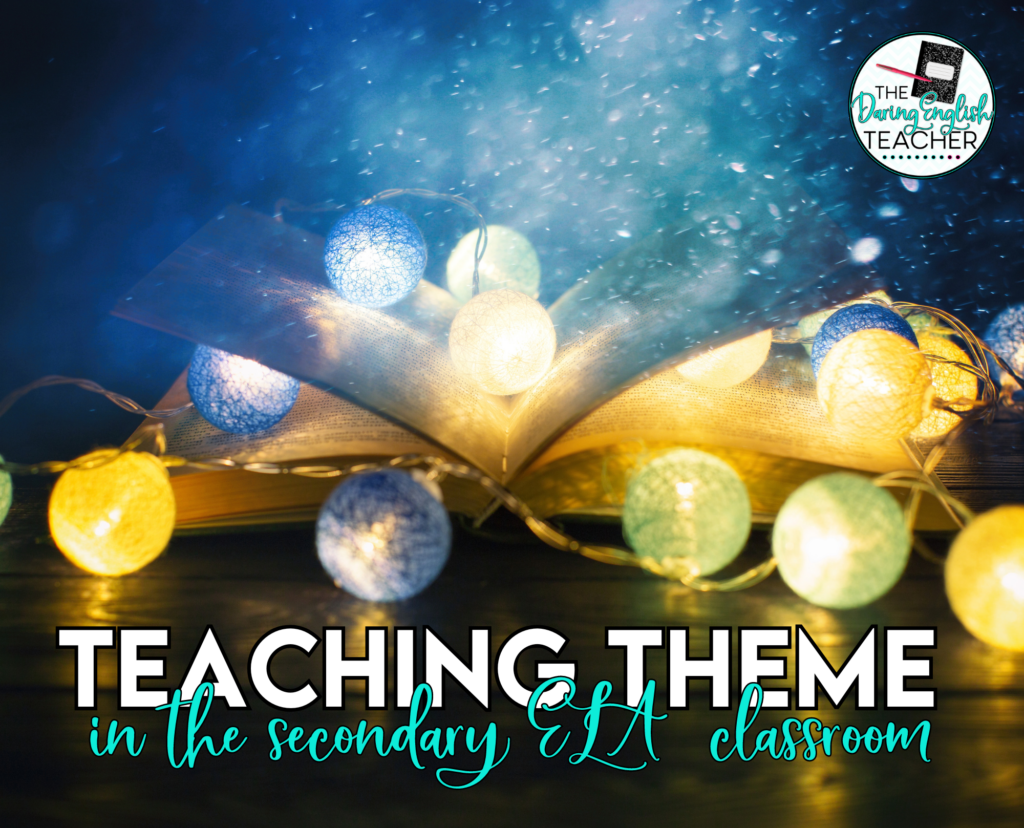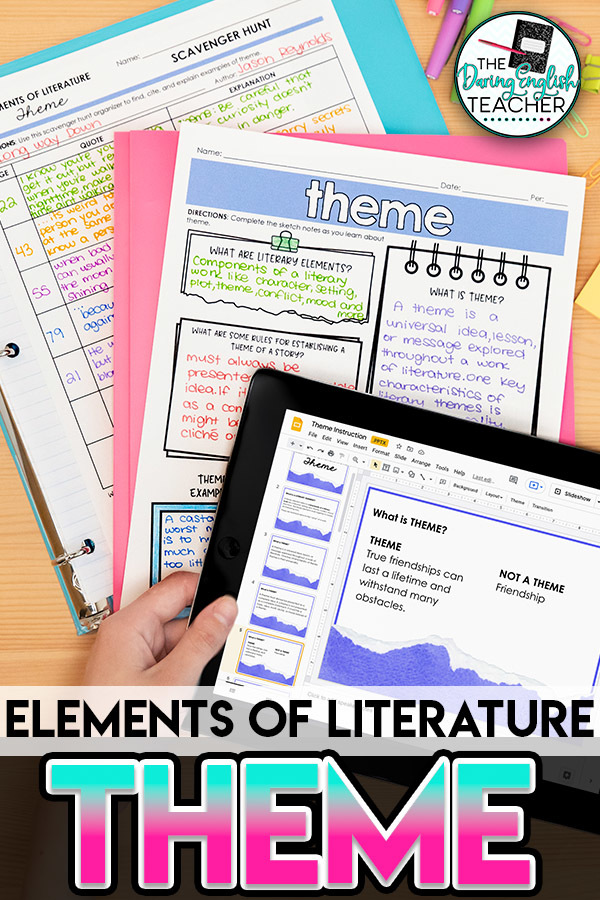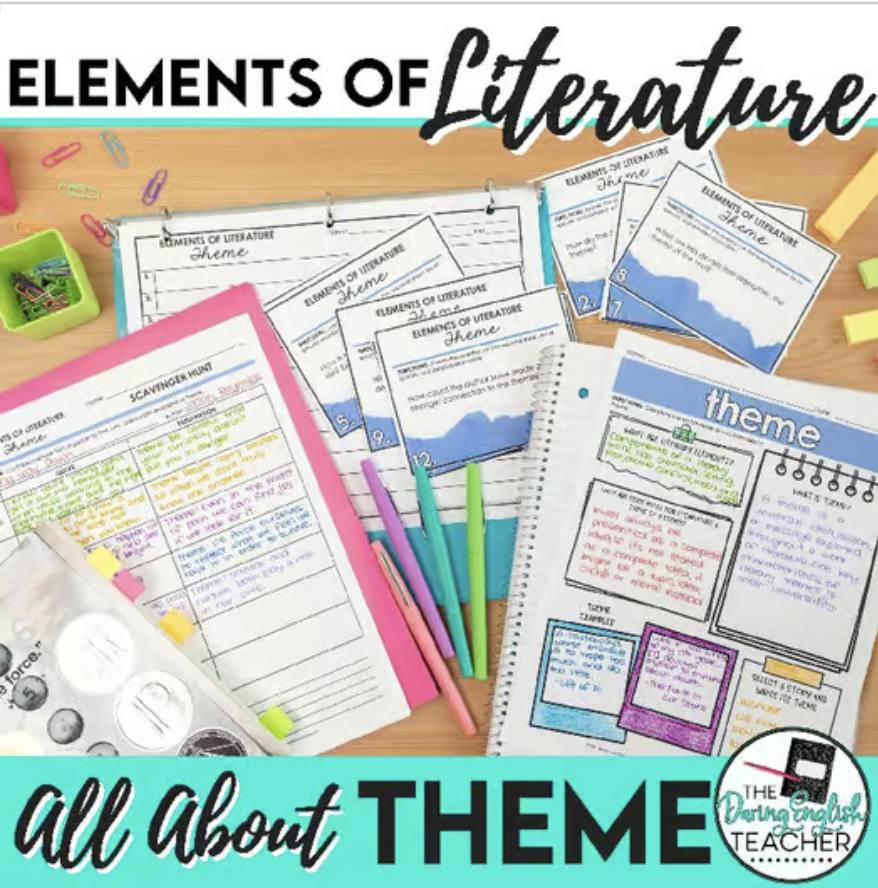
Exploring the world of literature is like to setting off on a daring journey (hence my name, The Daring English Teacher) through diverse human experiences, and at the heart of every compelling story lies a theme—a beacon illuminating the truths and timeless lessons woven into the fabric of storytelling.
And even more elusive than determining a story’s theme is teaching theme in the secondary ELA classroom.
Teaching Theme: What is Theme?
Theme serves as the underlying message, insight, or universal truth conveyed by a literary work. It transcends the plot’s surface-level events, offering readers a deeper understanding of human nature, society, and the complexities of existence. Themes resonate with readers on a personal level, inviting introspection, empathy, and reflection long after the final page is turned. Even more so, themes can transcend the ages and be universally applied to all.
Distinguishing Theme from ELA Related Concepts:
When it comes to teaching theme, many students think they have an idea of what theme is, but so many of them get confused with related ELA concepts. For teaching theme, it is important to distinguish theme from topic, motif, cliche, moral, and main idea.
In my Theme: Elements of Literature Mini-Unit, students will have the opportunity to analyze a story’s theme.

- Theme vs. Topic:
- While theme goes into the deeper meaning or message of a work, the topic simply refers to the subject matter or general subject discussed within the text. For example, while the topic of a novel might be “war,” the theme could explore the effects of war on humanity or the search for redemption amidst conflict. However, the theme of a story will never be “war” as an isolated word.
- Theme vs. Motif:
- While theme represents the overarching idea of a literary work, a motif is a recurring element, symbol, or image that contributes to the development of that theme. Motifs serve as symbolic threads connected throughout the narrative, reinforcing the central message. For instance, in To Kill a Mockingbird, the motif of mockingbirds symbolizes innocence and the unjust persecution of the innocent. However, the theme of a story will never be “mockingbirds” as an isolated word.
- Theme vs. Cliche:
- While themes resonate with universal truths and offer profound insights, cliches are overused expressions or ideas lacking originality or depth. Themes explore timeless concepts in fresh and nuanced ways, whereas cliches rely on tired, predictable phrases or sentiments. For instance, while the cliche of “love conquers all” can be explored in various nuanced ways, it isn’t enough to form a theme. Instead, a theme might be “true love has the power to conquer all obstacles.”
- Theme vs. Moral:
- While theme explores broader concepts and societal commentary, morals are specific lessons or principles conveyed within a story. Themes provoke thought and reflection on complex issues, while morals often offer clear-cut lessons or ethical guidelines. For example, while the theme of The Great Gatsby might explore the emptiness of the American Dream, a moral within the story could be the consequences of moral corruption and materialism. However, “the consequences of moral corruption and materialism” is not a complete theme.
- Theme vs. Main Idea:
- While theme encapsulates the overarching message or central idea of a work, the main idea refers to the primary point or focus of a specific passage, paragraph, or section within the text. The main idea provides readers with a succinct summary of the content or argument presented in a particular segment, whereas theme encompasses broader concepts explored throughout the entire work.
Teaching Theme: How to Identify Theme in a Story:
Identifying theme requires careful analysis and consideration of the narrative’s elements and underlying messages. Here are some strategies to use when you are teaching theme to help your students identify theme in the text.
- Teaching Theme – Analyze Characters: Pay attention to how characters evolve throughout the story and the lessons they learn along the way. Themes often manifest through character development and interactions.
- Teaching Theme – Analyze Symbols and Imagery: Look for recurring symbols, metaphors, or imagery that contribute to the deeper meaning of the text. These elements often serve as vehicles for conveying thematic concepts.
- Teaching Theme – Consider the Author’s Message: Reflect on the author’s intent and the societal or philosophical questions raised within the narrative. Themes reflect the author’s perspective on these issues and prompt readers to contemplate their own beliefs and values.
- Teaching Theme – Evaluate the Story’s Conflict: Consider how conflicts are resolved and the implications of these resolutions on the story’s themes. Themes may be reinforced or challenged through the resolution of key conflicts.
- Teaching Theme – Analyze Tone and Mood: Take note of the emotional atmosphere created by the narrative’s tone and mood. Themes often resonate through the overall mood of the text and the emotional responses elicited in readers.
For further reading about analyzing and teaching theme in the ELA classroom, check out this blog post: 4 Ways to Analyze Theme.
Teaching Theme Mini-Unit

Teach your students all about theme with this engaging elements of literature theme teaching unit. This teaching theme instructional unit includes an 18-slide presentation that reviews definition, annotates theme examples from literature, and student practice from literature.
Furthermore, this resource includes student sketch notes for note taking, a theme scavenger hunt for any text, and 12 theme task cards that can be used with any text.

